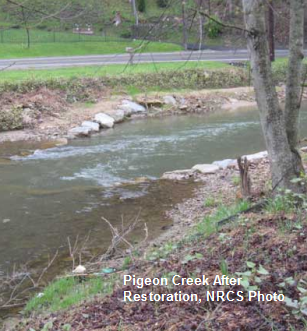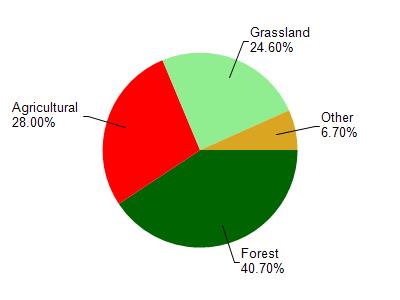
7.52 Miles
0 - 7.52
Cool-Cold Mainstem, Cool-Warm Mainstem
2025
Poor
High Phosphorus Levels
Total Phosphorus
Trempealeau
Yes
No
Yes
Fish and Aquatic Life
Overview
Pigeon Creek is an 22-mile-long tributary to the Trempealeau River, whose mouth can be found at Whitehall. Several mill and power plants are located along Pigeon Creek. It is currently used as a Warm Water Forage Fishery, but has the potential to become a Class III Trout water.
Date 2011
Author Aquatic Biologist
Impaired Waters
Pigeon Creek, from its mouth to Pigeon Falls Pond (mile 0-7.52), was evaluated for phosphorus and biology every two years between 2014 and 2022. Phosphorus levels were found to be too high. This stream was placed on the Impaired Waters List for phosphorus in 2014.
Pigeon Creek, within Pigeon Falls Pond (mile 7.52-7.93), was evaluated for phosphorus and biology in 2014 and 2016. Phosphorus levels were found to be too high. Additional assessment of biology in the 2020 and 2022 cycles showed fish communities in good health.
Pigeon Creek, from Pigeon Falls Pond inlet to CTH FF (mile 7.93-14.89), was put on the Impaired Waters List in the 2020 cycle for phosphorus. Evaluation of fish communities every two-year cycle from 2018 to 2022 showed they were healthy.
Pigeon Creek, from CTH FF to headwaters (mile 14.89-21.72), was assessed during the 2016 listing cycle; general mIBI assessment indicates that this water is meeting Fish and Aquatic Life use.
Date 2022
Author Ashley Beranek
Condition
Wisconsin has over 84,000 miles of streams, 15,000 lakes and milllions of acres of wetlands. Assessing the condition of this vast amount of water is challenging. The state's water monitoring program uses a media-based, cross-program approach to analyze water condition. An updated monitoring strategy (2015-2020) is now available. Compliance with Clean Water Act fishable, swimmable standards are located in the Executive Summary of Water Condition in 2018. See also the 'monitoring and projects' tab.
Reports
Recommendations
Citizen-Based Stream Monitoring
Expansion of a citizen based stream monitoring program within the Elk Creek watershed is recommended.
Citizen-Based Stream Monitoring
Expansion of a citizen based stream monitoring program within the Elk Creek watershed is recommended.
Management Goals
Wisconsin's Water Quality Standards provide qualitative and quantitative goals for waters that are protective of Fishable, Swimmable conditions [Learn more]. Waters that do not meet water quality standards are considered impaired and restoration actions are planned and carried out until the water is once again fishable and swimmable
Management goals can include creation or implementation of a Total Maximum Daily Load analysis, a Nine Key Element Plan, or other restoration work, education and outreach and more. If specific recommendations exist for this water, they will be displayed below online.
Monitoring
Monitoring the condition of a river, stream, or lake includes gathering physical, chemical, biological, and habitat data. Comprehensive studies often gather all these parameters in great detail, while lighter assessment events will involve sampling physical, chemical and biological data such as macroinvertebrates. Aquatic macroinvertebrates and fish communities integrate watershed or catchment condition, providing great insight into overall ecosystem health. Chemical and habitat parameters tell researchers more about human induced problems including contaminated runoff, point source dischargers, or habitat issues that foster or limit the potential of aquatic communities to thrive in a given area. Wisconsin's Water Monitoring Strategy was recenty updated.
Grants and Management Projects
Monitoring Projects
| WBIC | Official Waterbody Name | Station ID | Station Name | Earliest Fieldwork Date | Latest Fieldwork Date | View Station | View Data |
|---|
| 1792500 | Pigeon Creek | 10021104 | Pigeon Creek At Sth 53 | 7/25/2007 | 10/27/2025 | Map | Data |
| 1792500 | Pigeon Creek | 10014005 | Pigeon Creek atDaggett Coulee Creek | 10/11/1996 | 10/11/1996 | Map | Data |
| 1792500 | Pigeon Creek | 623048 | Pigeon Creek - 500' Below Stp Outfall | | | Map | Data |
| 1792500 | Pigeon Creek | 10045004 | Pigeon Creek Discharge from dam gate | 6/15/2016 | 8/6/2025 | Map | Data |
| 1792500 | Pigeon Creek | 10021389 | Pigeon Creek - Dissmore Coulee Rd. Crossing | 1/1/2015 | 1/1/2015 | Map | Data |
| 1792500 | Pigeon Creek | 623047 | Pigeon Creek - Above Stp Outfall | 5/24/2018 | 5/29/2025 | Map | Data |
| 1792500 | Pigeon Creek | 623007 | Pigeon Creek - Pigeon Falls Stp | 9/13/1979 | 9/13/1979 | Map | Data |
| 1792500 | Pigeon Creek | 10013427 | Pigeon Creek-Pigeon Falls Dam Down Stream 1575 ft | 1/1/2015 | 1/1/2015 | Map | Data |
| 1792500 | Pigeon Creek | 10021309 | Pigeon Creek | | | Map | Data |
| 1792500 | Pigeon Creek | 10021308 | Pigeon Creek | | | Map | Data |
| 1792500 | Pigeon Creek | 10021310 | Pigeon Creek | | | Map | Data |
| 1792500 | Pigeon Creek | 10016651 | Pigeon Creek - 50 Ft. Below Bridge On Thompsoncoulee Rd. | 10/11/1996 | 10/11/1996 | Map | Data |
| 1792500 | Pigeon Creek | 10021174 | Pigeon Creek | | | Map | Data |
|

Watershed Characteristics
Pigeon Creek is located in the Pigeon Creek watershed which is 93.15 mi². Land use in the watershed is primarily forest (40.70%), agricultural (28%) and a mix of grassland (24.60%) and other uses (6.70%). This watershed has 227.20 stream miles, 96.56 lake acres and 1,824.32 wetland acres.
Nonpoint Source Characteristics
This watershed is ranked Not Ranked for runoff impacts on streams, Not Available for runoff impacts on lakes and Medium for runoff impacts on groundwater and therefore has an overall rank of Medium. This value can be used in ranking the watershed or individual waterbodies for grant funding under state and county programs.However, all waters are affected by diffuse pollutant sources regardless of initial water quality. Applications for specific runoff projects under state or county grant programs may be pursued. For more information, go to surface water program grants.
Pigeon Creek is considered a Cool-Cold Mainstem, Cool-Warm Mainstem under the state's Natural Community Determinations.
Natural communities (stream and lake natural communities) represent model results and DNR staff valiation processes that confirm or update predicted conditions based on flow and temperature modeling from historic and current landscape features and related variables. Predicated flow and temperatures for waters are associated predicated fish assemblages (communities). Biologists evaluate the model results against current survey data to determine if the modeled results are corect and whether biological indicators show water quaity degradation. This analysis is a core component of the state's resource management framework. Wisconsin's Riverine Natural Communities.
Cool (Cold-Transition) Mainstem streams are moderate-to-large but still wadeable perennial streams with cold to cool summer temperatures. Coldwater fishes are common to uncommon, transitional fishes are abundant to common, and warm water fishes are uncommon to absent. Headwater species are common to absent,
mainstem species are abundant to common, and river species are common to absent.
The forage fishery in the lower 12.9 miles, and the trout fishery in the upper 9.1 miles are not supporting their use potential due to livestock grazing on the streambanks and agricultural runoff. The forage fish portion of the stream could support a trout fishery and the Class II brook trout portion of the stream from Northfield upstream could be improved to Class I if nonpoint source pollution was controlled.
Date 1991
Author Aquatic Biologist